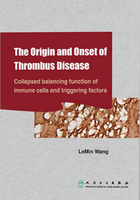
上QQ阅读APP看书,第一时间看更新
2.Protein components analysis of acute venous thrombus
The acute venous thrombosis freshly taken out from the body is red to the naked eyes and is fragile. It is composed of red blood cells, platelets, white blood cells and plasma proteins under microscope.
Mass spectrographic analyses have shown that a majority of the proteins in the thrombus are fibrinogen, the the remaining being mainly serum albumin and cytoskeletal proteins [5]. The reversible combinations between the receptor and their ligand-- fibrinogens suggest that acute venous thrombus is easy to autolyze and delayed thrombolysis is effective, so it should be easy to lyse the thrombus through interventional fragmentation.
Acute venous thrombus is red and is composed of red blood cells, platelets, white blood cells and fibrinogen. But how does fibrinogen bind to blood cells in the formation of thrombus? MS/MS and bioinformatics analyses of thrombus in patients with acute PE have shown that subunits β1, β2 and β3 in integrins are the core proteins of acute venous thrombus.
Integrins, important members in cell adhesion molecule family, mediate the adhesion between cells and between cells and extracellular matrix (ECM) and are involved in the bidirectional signaling transduction between cells and ECM. They combine to different ligands in various cellular processes, either physiological or pathological, such as angiogenesis, invasion, metastasis, inflammation, wound healing and coagulation [6].
Integrin is a transmembrane heterodimer composed of subunits α and β at a ratio of 1∶1. To date, a total of 18 α subunits and 8 β subunits have been identified and they form 24 functional heterodimers, which may be classified into 8 groups (β1-β8) on the basis of β subunit. In the same group, the β subunits are identical but the α subunits are distinct. At rest, the α subunit is covered by the β subunit and thus the integrin is unable to bind to ligands. Following activation, the extension of the β subunit exposes the α subunit. The α subunit mainly mediates the specific and reversible binding between integrins and their ligands, and the β subunit dominates the signal transduction and regulation of affinity of the integrins [7-9].